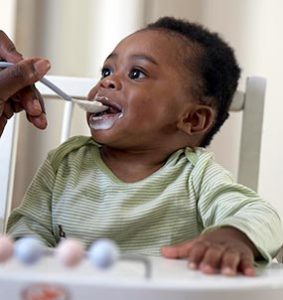Food For Thought – Starting Solids

Recently, my daughter has been trying her first foods, and it has been an adventure for her, my husband, and me! For her, it is a playful and sensory-filled learning activity. For us, it is fun to watch her try new things (and look adorable doing it). Starting solid foods with your baby is exciting, but it can come with many questions. How do you move from a milk-only diet to introducing food? How do you know when your baby is ready? Is it safe?
There are two different methods of introducing food to babies: purees and baby-led weaning. Using purees involves spoon-feeding your baby food, often from a jar or pouch. Baby-led weaning introduces the baby to solids via self-feeding food with their fingers. Purees are the more common way of introducing solids, but baby-led weaning has recently gained popularity. Baby-led weaning encourages independ ence. It also helps babies explore different textures. Using purees can be less messy, and there may be less wasted food. However, you will still need to make the transition to solids beyond purees. Of course, you could also use a combination of purees and baby-led weaning. I chose to try baby-led weaning while also using some pureed foods. So many parenting decisions come down to what is the best fit for your family! Read more about the benefits of each feeding style here.
ence. It also helps babies explore different textures. Using purees can be less messy, and there may be less wasted food. However, you will still need to make the transition to solids beyond purees. Of course, you could also use a combination of purees and baby-led weaning. I chose to try baby-led weaning while also using some pureed foods. So many parenting decisions come down to what is the best fit for your family! Read more about the benefits of each feeding style here.
Once you have decided which method to use, you may wonder how to know your baby is ready for solids. There are certain readiness signs to look for before beginning. Your baby should be able to sit up with minimal assistance and have good head control. They should also be able to grab objects. Finally, they should be showing interest in eating food. Most babies will be ready around six months. Current guidelines do not recommend starting solids sooner than six months. When your child meets these criteria, it is an excellent time to begin! For further information regarding readiness, check out this article.
 Honestly, I think my daughter was ready to start solids before I was ready for her to begin! Although she was meeting all the signs of readiness, I was nervous for safety reasons: choking and allergic reactions made me nervous. The best way to overcome these common concerns is to educate yourself. Make sure you understand the difference between gagging and choking and know what to do in the case of choking. Check out this free Infant Rescue Guide. It can also be a good idea to take an infant CPR class. Santiam CPR offers a class free to parents. Additionally, I recommend reading about allergies. According to Solid Starts, mild reactions include having one of the following symptoms: “itchy or runny nose, sneezing, itchy mouth, few isolated hives, mild itching, mild nausea or gastrointestinal discomfort,” while a severe reaction can include the following: “shortness of breath, wheezing, repetitive cough, pale, ashen or bluish skin, swelling of face, lips, or tongue, widespread hives on body, repetitive vomiting, sudden tiredness/lethargy/seeming limp.” In the case of a mild allergic reaction, you can contact your doctor, but in the case of a severe reaction, you should call 911. In addition to understanding what to look for and how to respond to allergic reactions, recognizing the statistics on allergies reassured me that while allergies can be serious, they are not an overly common problem. If you have questions or concerns about safety when starting solids, it is always a good idea to consult your pediatrician.
Honestly, I think my daughter was ready to start solids before I was ready for her to begin! Although she was meeting all the signs of readiness, I was nervous for safety reasons: choking and allergic reactions made me nervous. The best way to overcome these common concerns is to educate yourself. Make sure you understand the difference between gagging and choking and know what to do in the case of choking. Check out this free Infant Rescue Guide. It can also be a good idea to take an infant CPR class. Santiam CPR offers a class free to parents. Additionally, I recommend reading about allergies. According to Solid Starts, mild reactions include having one of the following symptoms: “itchy or runny nose, sneezing, itchy mouth, few isolated hives, mild itching, mild nausea or gastrointestinal discomfort,” while a severe reaction can include the following: “shortness of breath, wheezing, repetitive cough, pale, ashen or bluish skin, swelling of face, lips, or tongue, widespread hives on body, repetitive vomiting, sudden tiredness/lethargy/seeming limp.” In the case of a mild allergic reaction, you can contact your doctor, but in the case of a severe reaction, you should call 911. In addition to understanding what to look for and how to respond to allergic reactions, recognizing the statistics on allergies reassured me that while allergies can be serious, they are not an overly common problem. If you have questions or concerns about safety when starting solids, it is always a good idea to consult your pediatrician.

Introducing your baby to food can be overwhelming, but taking time to read about the process can help you feel prepared. You might still feel a little nervous at first, but it can also be so fun and exciting. Check out @solidstarts and @the.baby.dietician on Instagram for more information and inspiration.
More resources:
- For more information about how to know if your baby is ready to starting eating foods, what first foods to offer, and what to expect, watch these videos from 1,000 Days.